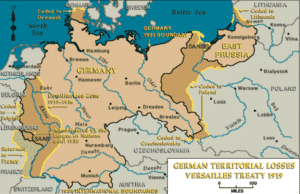Deutsche als Einwanderer. Wer durch die Straßen (großer) deutscher Städte geht, wird festgestellt haben, wie ethnisch vielfältig das Land ist. Nach Angaben des Ausländerzentralregisters (AZR) waren im Jahr 2020 rund 11,4 Millionen Menschen im AZR registriert. Auf der Website der Bundeszentrale für politische Bildung wurden Daten präsentiert, die zeigen, dass 26 % der deutschen Bevölkerung einen Migrationshintergrund haben, davon sind 52,4 % Deutsche und 47,6 % Migranten der ersten Generation.
But if we look back into German history, we see that the situation was reversed a few years ago. In interwar Europe, Germans were the continent's great migrants. Historian Mark Mazower points out that in 1930, out of 36 million members of ethnic minorities in Eastern Europe, between 8 and 9 were Germans. Thone Ulf tells us that of the 31 European states in the post-World War I period, 21 had a German ethnic minority.
To explain this scenario, we must first understand the context of Europe after the end of the war. The Treaty of Versailles, which was responsible for ending the war, hit Germany particularly hard, as it imposed significant territorial losses on the country, in addition to some financial reparations and the blame for the conflict, and with the loss of these territories, the population was consequently deprived of German citizenship.
These territories were granted to other states; the Memel region was incorporated into Lithuania, the territory of Hulchin was incorporated into Czechoslovakia, Alsace and Lorraine were returned to France (this had been under German control since 1871, at unification), the French also took control of the Saar. Danzig, whose population was 96.5% German, also left the tutelage of the new German Republic and was given the status of a "free city" and even placed under the High Commissioner of the League of Nations. We can see the territorial losses on the map below.
Germans as immigrants in history
We also have the Treaty of Saint-Germain-en-Laye, which is responsible for the dissolution of the Austro-Hungarian monarchy and the creation of Austria. Both Germany and the newly formed Austrian nation claimed the unification of the two states. The claim was based on the fact that the vast majority of the "Austrian" population was German. But the request was not granted by the victorious nations
The dissolution of the Austrian Empire also meant territorial/population losses. Yugoslavia retained the regions of Styria and Carinthia, Bukovina was granted to Romania, the Germans in Bohemia, Moravia and Austrian Silesia were incorporated into Czechoslovakia, and in the southern region the territories of Tyrol, Trentino and Istria were granted to Italy (the last two actually consisted of an ethnic Italian majority, but Tyrol had a population of 86% Germans).
We can now understand why the ethnic German population was so prevalent in Europe in the early 1920s. Of course, such a situation would cause several conflicts a few years later, culminating in the outbreak of World War II. But this topic will be addressed in a later article. Here we can note that the European continent has always been a great amalgam of different nationalities coexisting peacefully or not at different moments of its history....read more
Authors: Bruna Doimo and Marcela Oliveira




